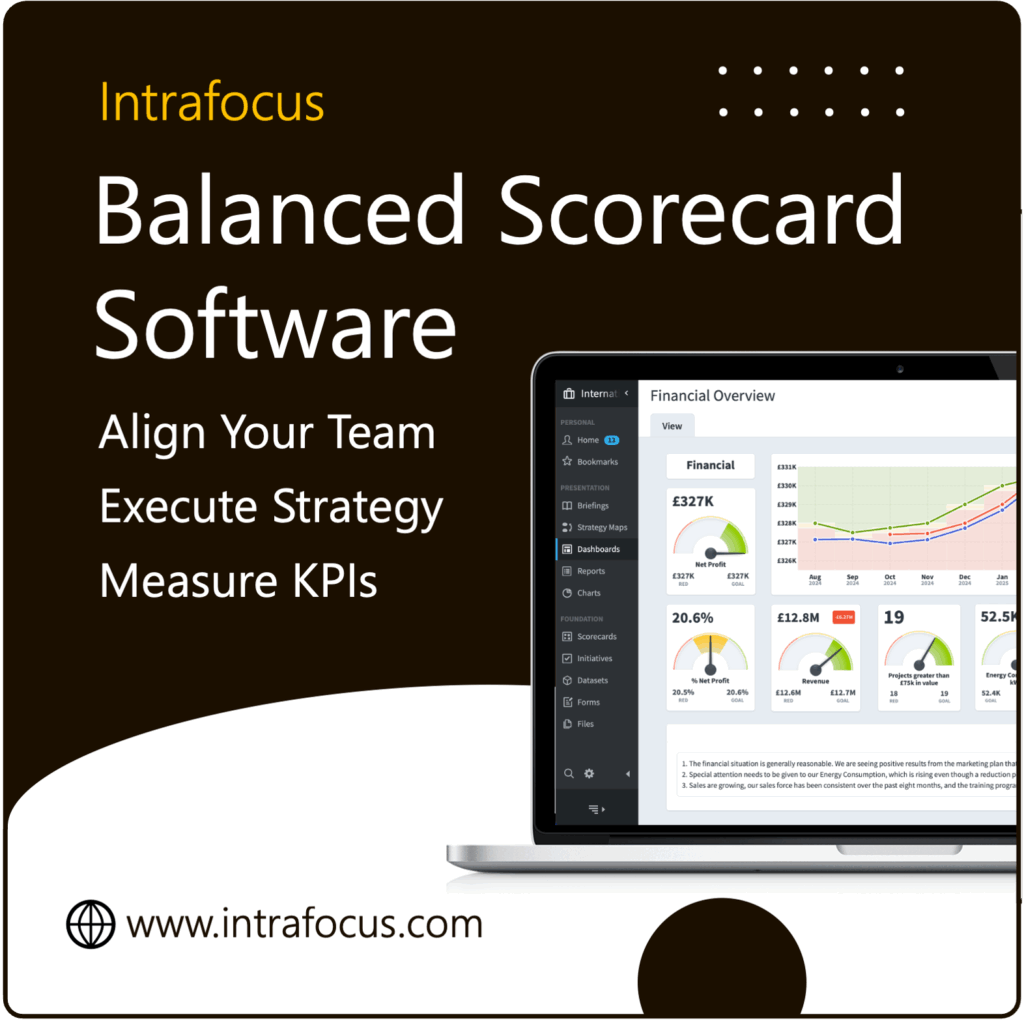Strategic planning 101, let’s get back to the basics. Have you ever tried to tackle something meaningful without a plan? Like setting off on a road trip with zero directions, no GPS, and just a vague notion that you want to “head west”? It’s all fun and adventure until you end up lost in a small town, eating gas station snacks and hoping you’re still going the right way.
Now, imagine running a business like that. “Winging it” might work for casual lunch plans, but the stakes are a little higher when growing a business. And if we’re honest, there are more directions to keep track of—financials, customer service and internal operations. Without a structured plan, it’s easy to end up miles away from where you want to be.
Resource: Balanced Scorecard software for UK & EMEA — Intrafocus is the international reseller.
The right plan can make the difference between chaos and success for small to mid-sized businesses. You might think, “But only big corporations need those fancy strategic processes!” Well, that’s like saying only professional athletes need coaches. Just as a coach helps players sharpen their skills, a strategic plan helps a business stay focused, improve performance, and adapt to change.
Take companies like Nike or Hilton, for example. Yes, they’re industry giants, but even they follow structured processes like the Balanced Scorecard to keep every part of the organisation aligned and moving toward their goals. They didn’t get to the top by winging it.
The good news? You don’t have to be a Fortune 500 company to benefit from a structured plan. In fact, small to mid-sized businesses have the most to gain from a strategic planning process. With the proper roadmap, you can maximise every pound, align your team, and keep the competition in the rearview mirror. So, let’s dive in and see why having a structured plan could be your business’s best investment.
A Structured Process for Growing Businesses
Imagine you’re juggling. Now add in a few more balls and maybe a flaming torch. That’s what running a growing business can feel like. As your business expands, there are more things to keep in the air: more customers, more employees, more data. Without a solid plan, it’s easy for things to come crashing down. That’s where a structured process comes in.
For small to mid-sized businesses, a strategic process like the Strategic Planning Process (SPP) can be the safety net that prevents everything from hitting the floor. It helps define goals, clarify priorities, and organize efforts so everyone knows what to focus on. Think of it as giving your business a GPS, guiding you through twists and turns while keeping you on course to success.
Why should small businesses consider a structured strategy? After all, you’re nimble and flexible—that’s your advantage! But the truth is, without structure, flexibility can quickly become chaos. The SPP is designed to give growing businesses direction without weighing them down. Each of its seven steps offers a clear purpose, from defining what your company stands for to automating your strategy so it doesn’t end up forgotten in a dusty spreadsheet.
Consider companies like Tesla. Known for its innovation and adaptability, Tesla uses strategic processes to stay aligned and focused in a fast-moving industry. Even as they pivot and adapt, they keep their eye on long-term goals, ensuring they’re not just reacting to the latest trend but moving purposefully.
Strategic planning 101. The Balanced Scorecard has helped companies like Hilton and UPS stay competitive by keeping everyone on the same page, from front-line employees to upper management. When every person in the company understands the objectives, goals become easier to reach. And with a structured process, smaller businesses can achieve that same alignment and focus.
With the right framework, your business isn’t just reacting to challenges; it’s prepared, proactive, and ready for growth. You’re not just juggling; you’re orchestrating.
Meet the SPP: Seven Steps to Success
Let’s face it: strategy can feel like a big, intimidating word. However, the beauty of the Strategic Planning Process (SPP) is that it breaks down strategy into seven manageable steps. Think of it as turning a marathon into a series of quick sprints—each with a clear destination and purpose. Let’s dive into the steps that can take your business from “We think we know where we’re going” to “We’ve got this!”
Step 1: Foundation
First things first—who are you? Before you even think about goals, you need a foundation. This step defines your business’s core values, vision, and purpose. It’s like saying, “We’re headed west.” Without it, you’re just wandering.
Step 2: Assessment
Now that you know where to go, it’s time for a reality check. This step uses tools like gap analysis, SWOT, and benchmarking to assess where you are now compared to where you want to be. Think of it as making a checklist before a big trip. What do you need, and what obstacles might you face?
Step 3: Strategic Objectives
Strategic objectives turn your priorities into specific, achievable goals. These are your “continuous improvement” activities under categories like Financial, Customer, Internal Processes, and Organizational Capacity. Imagine a coffee shop chain deciding it needs to focus on customer satisfaction and efficient operations. These objectives give everyone a clear role in making that happen.
Step 4: Measures
How do you know you’re making progress? That’s where Key Performance Indicators (KPIs) come in. You can track and measure these metrics over time, like a speedometer on a road trip. Companies like UPS track delivery times to ensure they’re meeting customer expectations. For you, KPIs might measure anything from sales to customer satisfaction.
Step 5: Projects
Now comes the action. Projects are the initiatives that push you closer to your goals. They’re like the rest stops on your journey—you’ll need to make them, but only after you’ve figured out your route. Whether launching a new product or fixing an internal process, projects make the strategy real.
Step 6: Communication
You’ve got a plan, but does your team know about it? Early and ongoing communication is essential for keeping everyone aligned. Think of it as the announcements on a road trip: “We’re stopping in 10 miles!” Communication keeps everyone on board.
Step 7: Automation
Finally, suppose you’re serious about tracking your progress. In that case, you’ll want software like Spider Impact to make your strategy easy to manage. Forget juggling spreadsheets—automation ensures you stay focused on your destination.
Tools of the Trade: Why Software Matters
Imagine running a marathon while carrying a stack of paper maps instead of just using GPS. That’s what trying to manage a business strategy with spreadsheets and presentations can feel like. Sure, you could do it, but it’s slow, cumbersome, and, let’s face it, a bit risky. That’s where strategy management software comes in.
With all the moving parts in a strategic plan, having the right software isn’t just a “nice to have”—it’s a game-changer. A tool like Spider Impact can help you see the whole strategy, track your progress, and quickly adjust. Think of it as your business’s GPS guiding you in real-time. Strategic Planning 101!
Here’s the problem with traditional tools like spreadsheets: they’re not built for strategy. They’re fine for numbers but terrible at capturing the full picture of your goals, KPIs, and projects all in one place. Plus, they’re easy to overlook. Without dedicated software, a strategic plan can quickly become a “file we’ll check later” instead of a living, breathing document.
With Spider Impact, you’re not just tracking numbers—you’re tracking impact. Companies like Coca-Cola and Siemens use strategy management software to keep every team member informed and aligned with company goals. The software makes setting targets, tracking KPIs, and evaluating progress efficiently, giving you a clear dashboard view of where you’re headed and how fast.
Investing in software may seem like a leap for a mid-sized business, but think of the time (and headaches) it can save. Not only does it keep everything organized, but it also makes it easy to communicate progress. Hence, everyone knows they’re moving in the right direction.
In short, don’t leave it to spreadsheets if you’re serious about achieving your strategic goals. Automate, simplify and keep your team focused on what matters most.
Ready to Level Up Your Strategy?
So, there you have it: the Strategic Planning 101, complete with seven steps to help your business stay on track, grow strategically, and keep your team in sync. With a clear plan, you’re not just drifting from one quarter to the next—you’re moving with purpose and confidence.
Implementing a structured process and using tools like Spider Impact can transform strategy from an abstract idea into tangible, trackable results. And the best part? To make it work, you don’t have to be a Fortune 500 company. Small to mid-sized businesses stand to gain the most from a strategic plan because it maximizes every resource, ensuring nothing gets wasted.
So, are you ready to leave “winging it” behind? Embrace the power of a well-defined strategy. Your business—and your sanity—will thank you for it.
If you are implementing or thinking about implementing a Balanced Scorecard, then please take a look at out Balanced Scorecard Software, Spider Impact.



